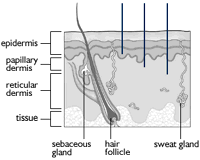Who does it help?
Lasers and energy devices can have an effect of sun damage and ageing of the face, they can reduces fine wrinkles, uneven pigmentation and rough skin.
Are there other options?
There are many options of laser and energey devices to treat skin.
Is this an alternative to surgical procedures?
No - they are different things. A facelift (rhytidectomy) lifts tissue and removes surplus skin. It is particularly good for the jaw and the neckline which is inaccessible to the laser or device. Excess skin is removed more precisely in an eyelid reduction (blepharoplasty) and the bags or bulging fat can be removed. Lasers and devices will reduce fine wrinkles and tighten the skin.

Typical wrinkles and pigment change due to sun damage.

The laser or device can be directed to trace specific areas or more commonly the whole face.
What is involved?
Small areas can be treated under local anaesthetic cream (EMLA, Ametop) or local anaesthetic injections. Intravenous sedation can be given by an Anaesthetist to supplement this, or if the patient prefers, a full general anaesthetic. This would be usual if the whole face is treated. After treatment the skin is raw and may be covered with ointment or a dressing.
Healing takes 7 to 10 days leaving the new skin red. Camouflage make-up is helpful in covering this. The redness usually fades after two to six months during which time sunshine should be avoided. Sun exposure increases the risk of the development of dark pigmentation. This is more common in patients with olive, brown or black skin.

For superficial or medium resurfacing, lasers and devices can be limited to the epidermis and papillary dermis. For deeper resurfacing, the upper levels of the reticular dermis can also be removed.
What are the risks?
Slight changes in pigmentation can occur. Any darkening can be treated but will tend to resolve spontaneously. Long term lightening of pigmentation is also a possibility. Scarring is rare with normal skin. The risk is greatest is patients known to produce keloids, who have been treated with radiotherapy in the area or have had a recent course of Roaccutane. Cold sores (herpes) can be reactivated. Patients with this tendency are given preventative treatment. Risks will be reduced by choosing a surgeon who is an accredited plastic surgeon trained in laser and devices.
Disclaimer
This website is designed to supply useful information but is not to be regarded as advice specific to any particular case. It does not replace the need for a thorough consultation and all prospective patients should seek the advice of a suitably qualified medical practitioner. The BAAPS accepts no liability for any decision taken by the reader in respect of the treatment they decide to undertake.